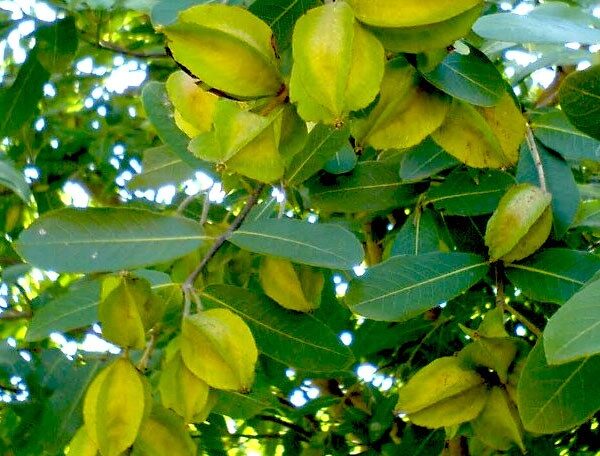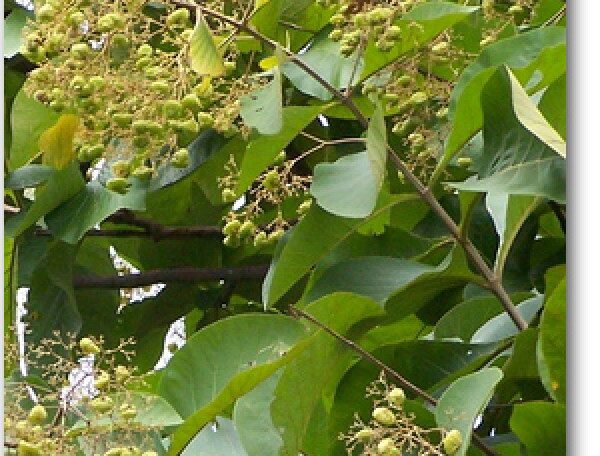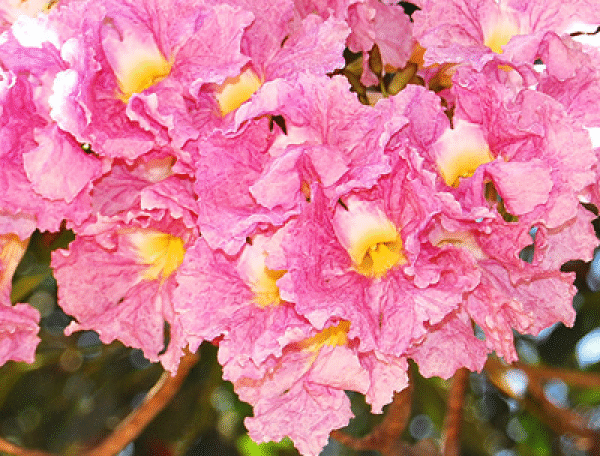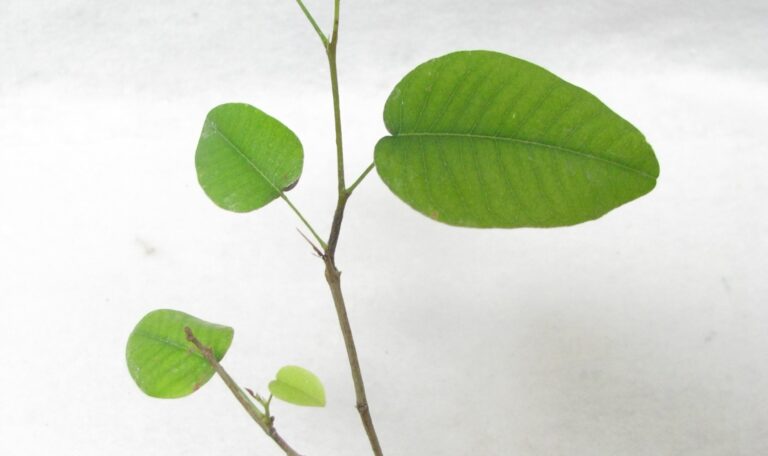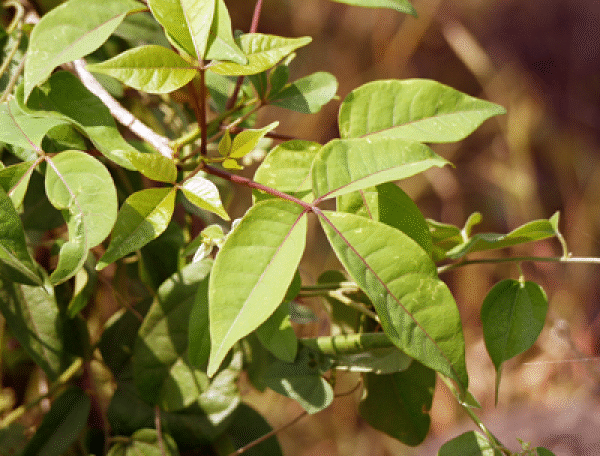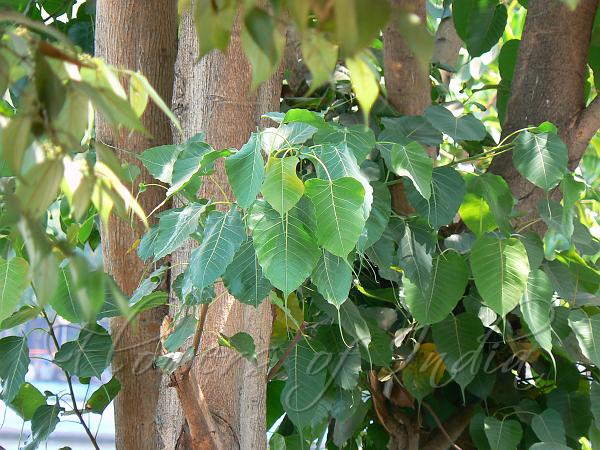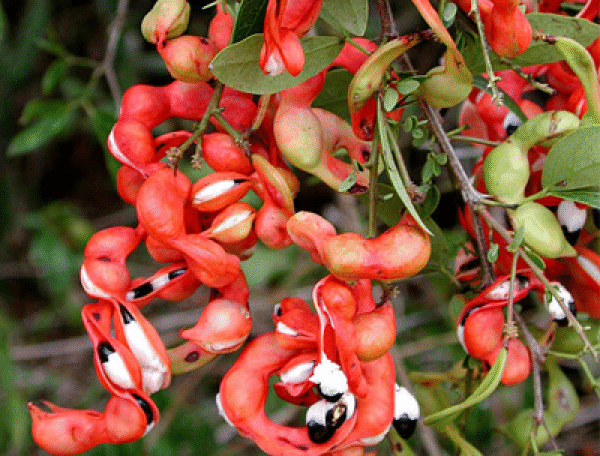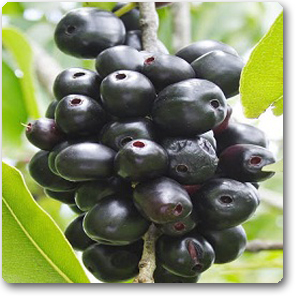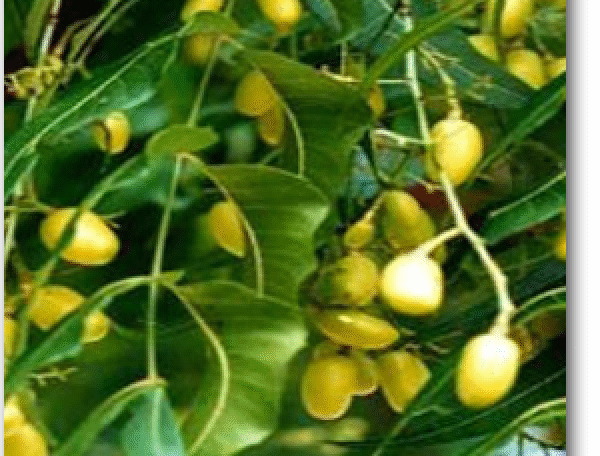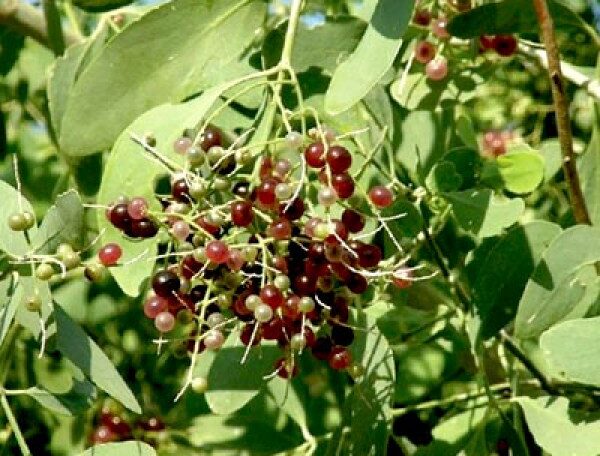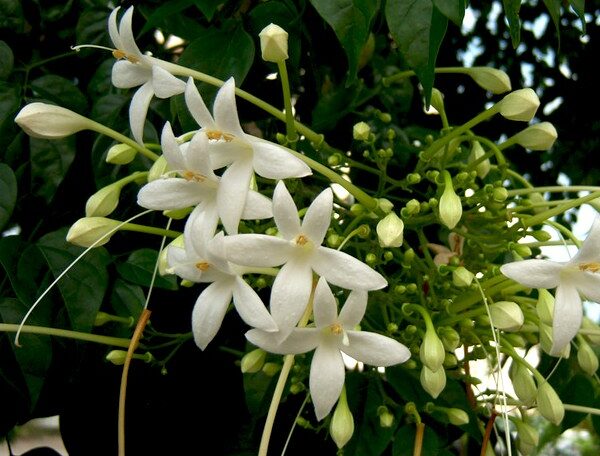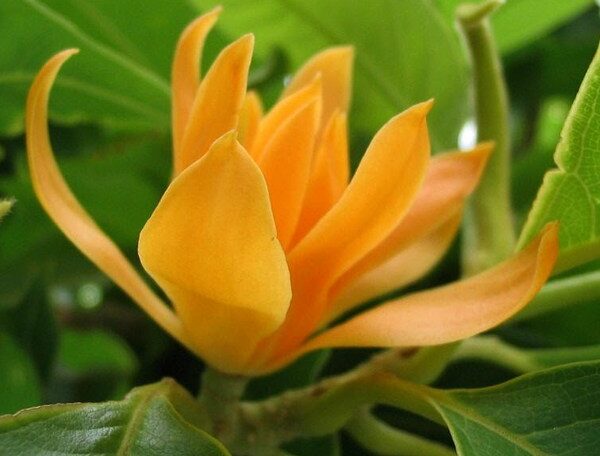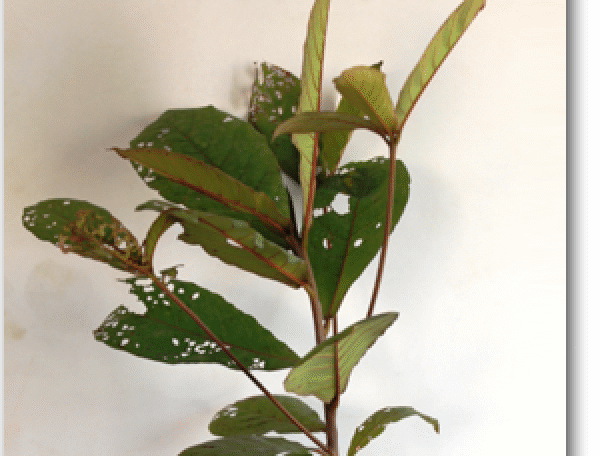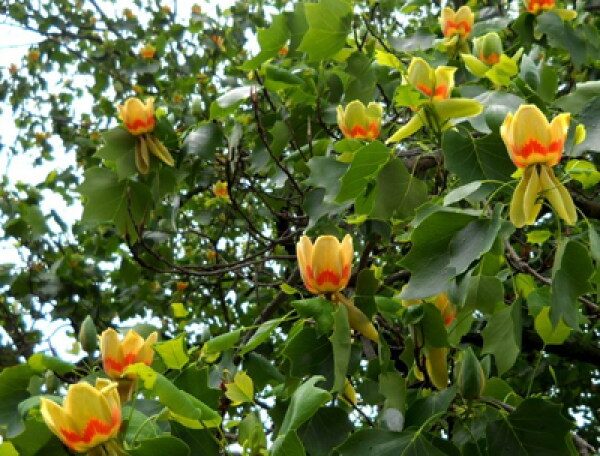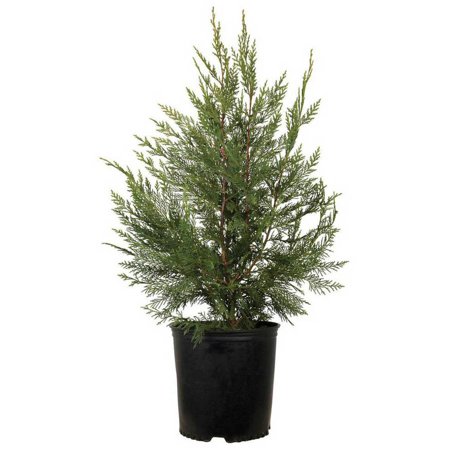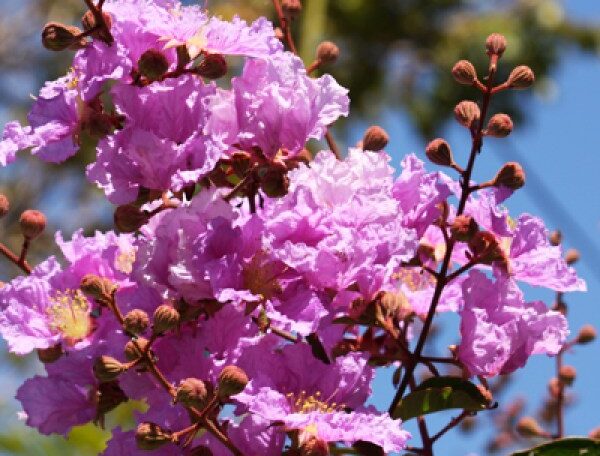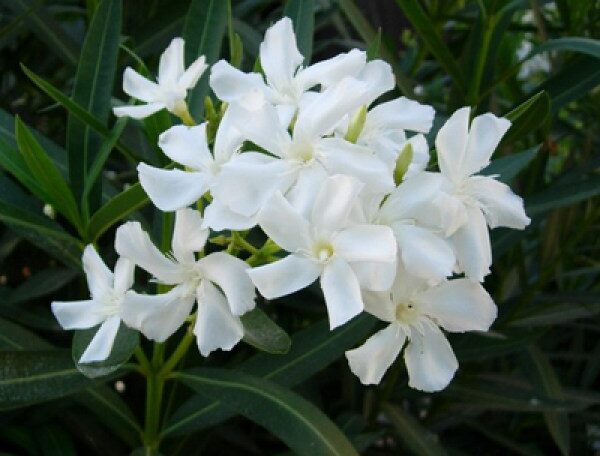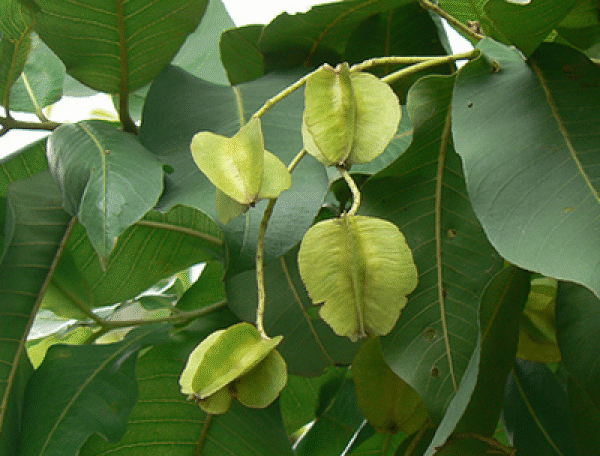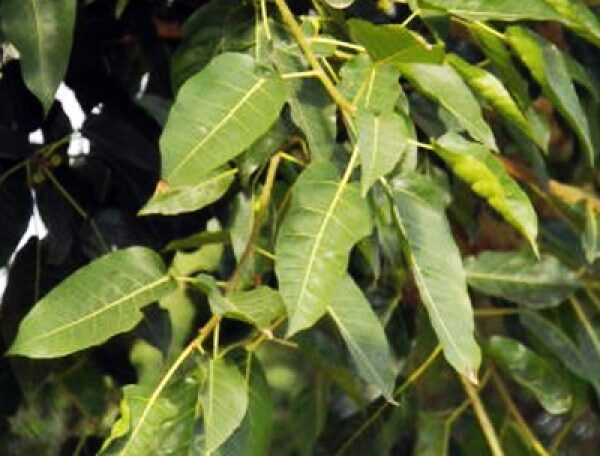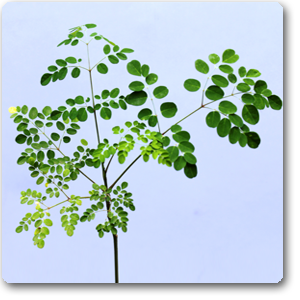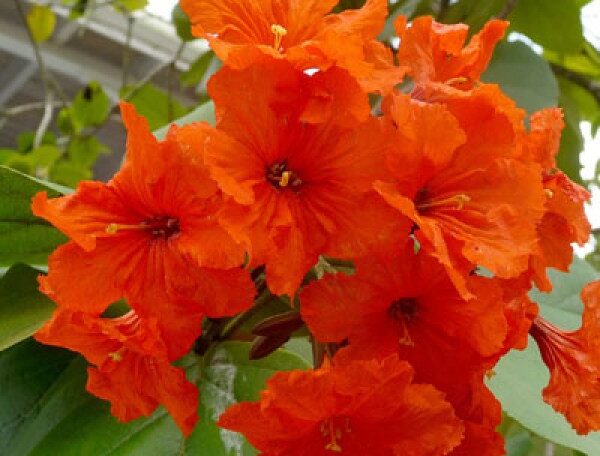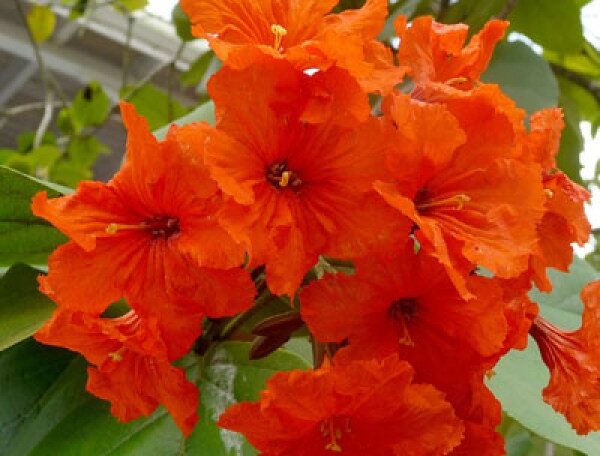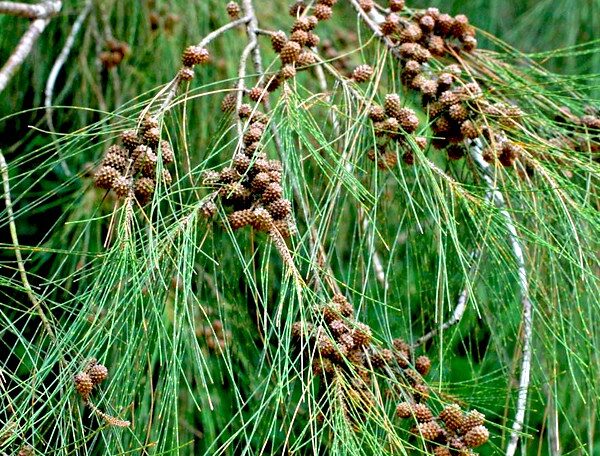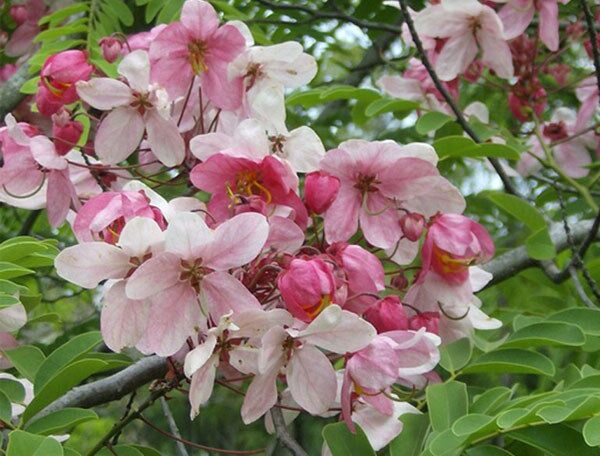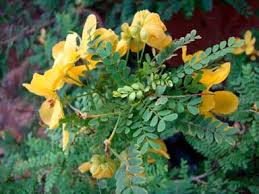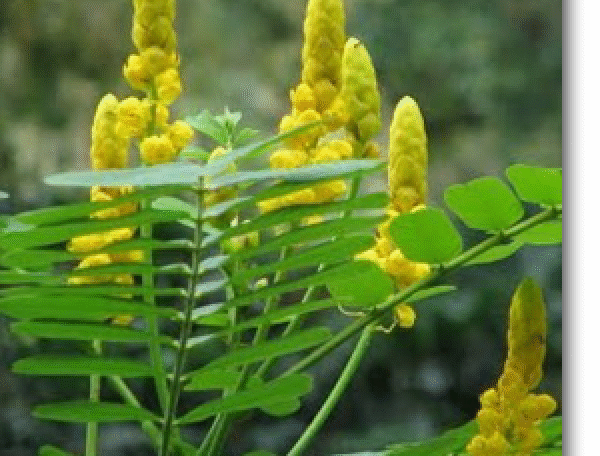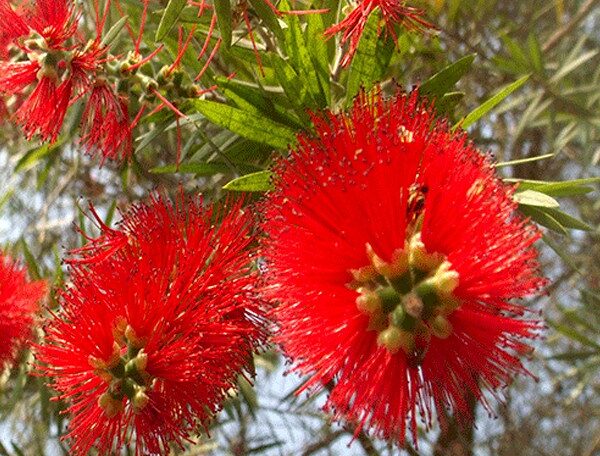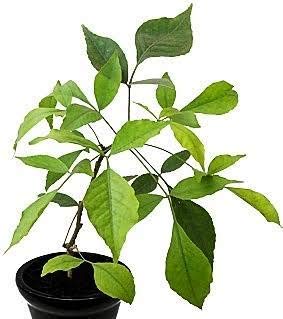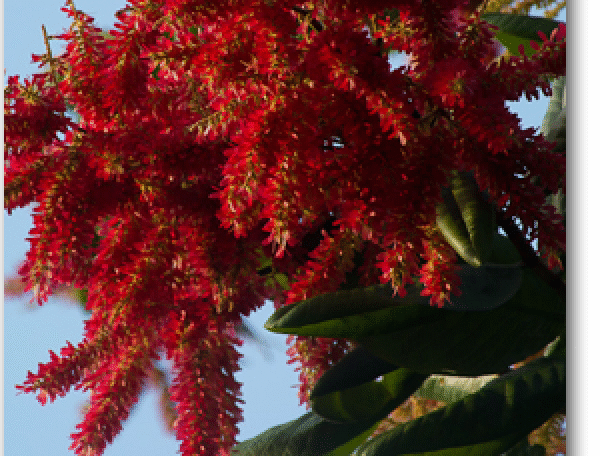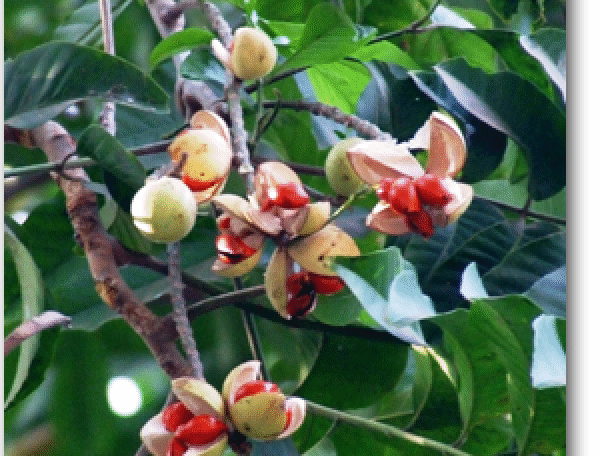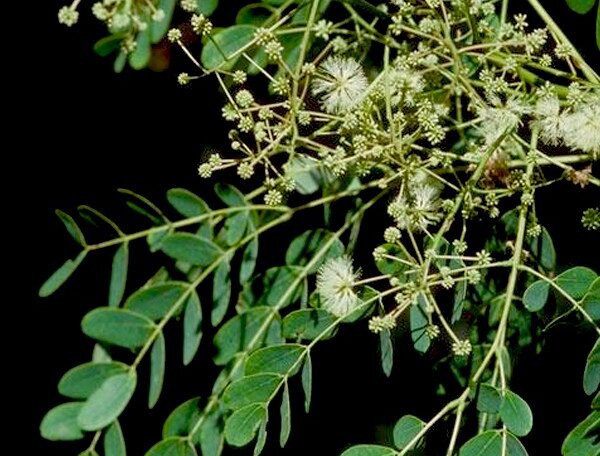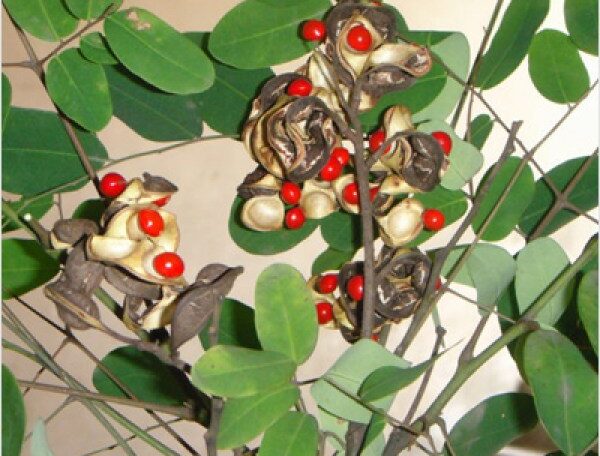Terminalia Arjuna Plant
Description for Terminalia Arjuna, Arjun Plant height: 18 - 28 inches Plant spread: 4 - 6 inches In Indian mythology, Arjun is supposed to be Sita's favorite tree. Native to India, the tree attracts lot of attention because of its association with mythology and its many uses. Arjuna is a large, evergreen tree, with a spreading crown and drooping branches. Grows up to 25 m height, and the bark is grey and smooth. Leaves are sub-opposite. Flowers are small, white, and occur on long hanging recemes. Fruit is 2.3-3.5 cm long, fibrous woody, glabrous and has five hard wings, striated with numerous curved veins. Flowering time of the tree is April-July, in Indian conditions. Common name(s): Arjuna, Arjun, and Kumbuk Flower colours: White to Pale Yellow Bloom time: April to July Max reachable height: Up to 25 meters Difficulty to grow: Easy to grow Planting and care It can easily
Terminalia Arjuna, Arjun
Description for Terminalia Arjuna, Arjun Plant height: 18 - 28 inches Plant spread: 4 - 6 inches In Indian mythology, Arjun is supposed to be Sita's favorite tree. Native to India, the tree attracts lot of attention because of its association with mythology and its many uses. Arjuna is a large, evergreen tree, with a spreading crown and drooping branches. Grows up to 25 m height, and the bark is grey and smooth. Leaves are sub-opposite. Flowers are small, white, and occur on long hanging recemes. Fruit is 2.3-3.5 cm long, fibrous woody, glabrous and has five hard wings, striated with numerous curved veins. Flowering time of the tree is April-July, in Indian conditions. Common name(s): Arjuna, Arjun, and Kumbuk Flower colours: White to Pale Yellow Bloom time: April to July Max reachable height: Up to 25 meters Difficulty to grow: Easy to grow Planting and care It can easily
Teakwood, Sagwan –
Description for Teakwood, Sagwan Plant height: 14 - 22 inches Plant spread: 4 - 6 inches Teak wood known as king of timber belongs to the family Verbenaceae. Its scientific name is Tectona grandis. It grows as a huge tree and yields excellent quality wood. Therefore teak wood has higher demand in national as well as International markets. Articles made of teak wood have high durability/quality and hence with the increased consumption of teak in household and office interiors, teak has become an indispensable part of people lives all over the world. Normally superior teak plants are grown on commercial scale, it is possible to earn good profits with low risk. Common name(s): Verbenaceae, Tectona grandis, Malabar teak, South and Central American teak, West African teak, Adilabad teak, Godhavari teak, Konni teak Flower colours: - Bloom time: - Max reachable height: - Difficulty to grow: Easy to grow Planting and
Tabebuia Rosea, Savannah Oak
Description for Tabebuia Rosea, Savannah Oak Plant height: 24 - 36 inches Plant spread: Tabebuia rosea, also called pink poui, and rosy trumpet tree is a neotropical tree that grows up to 30 m and can reach a diameter at breast height of up to 100 cm. Common name(s): Tabebuia Rosea, Savannah Oak -,tabebuia Flower colours: pink Bloom time: Seasonal bloomer Max reachable height: 60.00 to 90.00 feet Difficulty to grow: Easy. Planting and care After a good rain, find a spot that is the first to dry out. Water trapped beneath the scales may rot the bulb, so a well-drained site is essential. Also, select a site that gets full sun. For dependable blooms, plants need six to eight hours of direct sunlight a day. Sunlight: Full sun Soil: well-drained soil Water: Medium Temperature: 20C to 30C Fertilizer: Apply any organic fertilizer Caring for Tabebuia Rosea Clean away from
Tabebuia argentea, Tecoma argentea
Description for Tabebuia argentea, Tecoma argentea Plant height: 14 - 22 inches Plant spread: 4 - 8 inches The crown is usually asymmetrical with two or three major trunks or branches dominating the crown. The leaves are narrow and elongated, a key feature of the tree. The brilliant display composed of a multitude of two to three-inch-long, golden yellow, trumpet-shaped blooms borne in terminal flower clusters. Common name(s): Yellow Tabebuia, Golden Bell, Silver Trumpet Tree Flower colours: Yellow Bloom time: Spring, winter Max reachable height: Up to 30 feet Difficulty to grow: Easy to grow Planting and care It is very susceptible to damage during strong winds. Tabebuia can be also be grown in containers, especially small ones, which eventually can turn the tree into a large bonsai specimen. Sunlight: Full sun Soil: Well-drained soil Water: Keep moist, drier in the winter Temperature: 22 to 30 degrees C Fertilizer: Apply
Spathodea Campanulata, Fountain Tree
Description for Spathodea Campanulata, Fountain Tree Plant height: 14 - 22 inches Plant spread: 4 - 8 inches The tree has a stout, tapering, somewhat buttressed trunk covered in warty light gray bark. The tree flowers in spurts all through the growing season, but peak bloom is usually in the spring. African tulip tree is a large upright tree with glossy deep green pinnate leaves and glorious orange scarlet flowers. It may grow to 80 ft on an ideal site, but most specimens are much smaller. Common name(s): African tulip, Fountain tree, Rugtoora Flower colours: Glorious orange Bloom time: Spring, all through the growing season Max reachable height: 80 ft and less Difficulty to grow: Easy Planting and care Sunlight: African tuliptree will survive in shade, but demands full sun for fast growth and best flowering. Soil: This species loves rich soil, but puts up with just about anything with
Sisham, Indian Rosewood
Description for Sisham, Indian Rosewood Plant height: 15 - 23 inches Plant spread: 4 - 6 inches Dalbergia sissoo, known commonly as North Indian Rosewood, is a fast-growing, hardy deciduous rosewood tree native to the Indian Subcontinent and Southern Iran. D. Sissoo is a large, crooked tree with long, leathery leaves and whitish or pink flowers. Common name(s): Sisu, tahli, tali, irugudujava, biradi. Flower colours: Whitish to pink, Bloom time: September-December. Max reachable height: 4 to 7 feet Difficulty to grow: Easy to grow Planting and care Plant sesame in full sunlight spaced 2-3 feet apart to allow healthy development. Once established, sesame can thrive even in high temperatures with little water. Flowers will eventually develop into dozens of elongated seed pods. Seeds are ready to be harvested when these pods turn brown and begin to open. Sunlight: Full Sun to Partial Shade Soil: Well-drained soil Water: Medium Temperature: 77
Sesbania grandiflora, Hummingbird tree
Description for Sesbania grandiflora, Hummingbird tree Plant height: 10 - 16 inches Plant spread: 3 - 5 inches Sesbania grandiflora also was known as the vegetable hummingbird, Agati or hummingbird tree. This plant can fix the nitrogen in the soil. This plant is fast growing and light branching; grow up to 8 m in height. the plant bears the single white fragrant flowers from September to October month. Fruit pots are slender up to 30 cm in length. Common name(s): Agathi, West Indian Tree, Vegetable Humming bird, Aghastya, White Dragon tree Flower colours: White Bloom time: June to frost Max reachable height: Up to 8 m Difficulty to grow: Easy to grow Planting and care Sesbania grandiflora is propagated through seeds. Before sowing, seeds are soaked in the water for 12 hours. This plant required full sunlight to grow well. Apply organic fertilizer or manure in spring season. Sunlight: Full
Sausage Tree, Kigelia Pinnata
Description for Sausage Tree, Kigelia Pinnata Plant height: 3 - 6 inches Plant spread: Kigelia africana, commonly called sausage tree, is native to riverbanks, floodplains, open woodlands and savannas from sub-Saharan central Africa to South Africa. It typically grows to 50 to 60 tall with a stout trunk and rounded to spreading crown. Smooth, gray-brown bark may flake with age. Rough, pinnate-compound, yellowish-green leaves (to 8 long), with each leaf having 3 to 8 leaflets Common name(s): - Flower colours: Dark red Bloom time: Seasonal bloomer Max reachable height: 50 to 60 feet Difficulty to grow: Easy to grow Planting and care Sunlight: Full sun to part shade Soil: Well drained soil Water: Medium Temperature: 4 to 40 degrees C Fertilizer: A time released fertilizer 8-3-9 or similar. Caring for Sausage Tree Typical uses of Sausage Tree Special features: Ornamental use: The tree is widely grown as an ornamental tree
Sacred Barna Tree, Varun
Description for Sacred Barna Tree, Varun Plant height: 9 - 15 inches Plant spread: Common name(s): Sacred Barna Tree, Varun,Garlic pear tree, Caper tree, Three leaf caper, Obtuse Leaf Crateva . Flower colours: greenish-yellow, Bloom time: April and May Max reachable height: 25m Difficulty to grow: easy to grow Planting and care plant have long tap roots which need to stretch out so the plants prefer well-dug, loose, well-draining soil; in preparing a bed, dig down 2 feet in depth and about 3 feet across to ensure the soil isn’t too compact. Sunlight: Full Sun Soil: well-drained soil Water: Medium Temperature: - Fertilizer: Apply any organic fertilizer Caring for Sacred Barna Tree Feed plants only sparingly; over fertilization can cause stems to break in the fall. You can add diluted fertilizer into the water, though avoid getting the fertilizer near the plants base . it may help to build a
Powder Puff Plant, Calliandra
Description for Powder Puff Plant, Calliandra Plant height: 6 - 10 inches Plant spread: 5 - 9 inches Calliandra is a large genus of tropical plants that consists of about 200 species of small trees and evergreen, flowering shrubs. Calliandra haematocephala, commonly known as the Powder Puff Tree, is native to South America. Powder Puffs grow up to 10 feet tall with an equal spread, but dwarf, 3-6 foot varieties are also available. Common name(s): Powder Puff Plant, Calliandra,Calliandra haematocephala . Flower colours: Red Bloom time: Seasonal bloomer Max reachable height: 3.00 to 6.00 feet Difficulty to grow: Easy to grow Planting and care Calliandras grow and flower best if they are grown in full sun, but they tolerate some partial shade, especially in hot summer regions. They should be planted in reasonably fertile, moist but well-drained soil with a pH of 6.0-7.5.Powder Puff plants should be watered regularly and
Pongamia Pinnata, Karanj
Description for Pongamia Pinnata, Karanj Plant height: 19 - 29 inches Plant spread: 5 - 9 inches Pongamia pinnata, a fast-growing, hardy tree that is native to India and grows all over the world in sub-tropical climates. Pongamia grows robustly on dry, marginal land using its deep tap root and produces a large amount of oilseeds that can be mechanically harvested and processed using existing agriculture equipment. Common name(s): Pongamia Pinnata, Karanj, Indian Beech, Pongam Oiltree, Karanj, Honge ,Pungai nuga (Telugu), Naktam. Flower colours: Purple, pink, and white Bloom time: Annual Max reachable height: 8 meters Difficulty to grow: Easy to grow Planting and care Sunlight: Full sun. Soil: Can grow on most soil types ranging from stony to sandy to clay. Water: Draught taulerant Temperature: Maximum temperature ranges from 27 to 38C and the minimum 1 to16C. Fertilizer: Any organic fertilizers. Caring for Pongamia Pinnata Probably ranges from Tropical
Plumeria, Champa
Description for Plumeria, Champa (Yellow) Plant height: 15 - 23 inches Plant spread: 4 - 6 inches Plumerias are tropical trees famous for their gorgeous flowers which are used to make leis. In regions with cold winters, plumerias can be grown in containers and brought indoors when the weather cools in autumn. Other common names are frangipani and Hawaiian lei flower. Plumeria trees bloom in a variety of different colors. The tree itself is rather unusual in appearance; the 12 to 20 inch long, coarse, deciduous leaves cluster only at the tips of the rough, blunt, sausage like, thick, grey-green branches. Branches are upright and rather crowded on the trunk forming a vase or umbrella shape with age.They are rather soft and brittle and can break but are usually sturdy unless they are mechanically hit or disturbed. The crown loses its leaves for a short time during the winter displaying
Pithecellobium Dulce, Jungle Jalebi –
Description for Pithecellobium Dulce, Jungle Jalebi Plant height: 19 - 29 inches Plant spread: 4 - 8 inches Common name(s): - Flower colours: - Bloom time: - Max reachable height: - Difficulty to grow: - Planting and care Sunlight: - Soil: - Water: - Temperature: - Fertilizer: - Caring for Pithecellobium Dulce Typical uses of Pithecellobium Dulce Special features:
Pisonia Alba, Catchbirdtrees, Birdcatcher, Birdlime
Description for Pisonia Alba, Catchbirdtrees, Birdcatcher, Birdlime Plant height: 14 - 22 inches Plant spread: 3 - 5 inches This plant is used in the garden where dark foliage plants are planted to avoid dull appearance in the garden. Evergreen tropical tree of medium size, to 7 m height, with greenish-yellow or yellow-white foliage looking like lettuce, the thin leaf blades lanceolate and corrugated 10 to 30cm long, undulate at margins, clusters of tiny greenish white flowers, and 2cm long stalked fruit from female blooms. Cooked leaves are eaten as a vegetable. Common name(s): Pisonia Alba, Catchbirdtrees, Birdcatcher, Birdlime Flower colours: Green Bloom time: Rarely blooming Max reachable height: Upto 15 feet. Difficulty to grow: Easy. Planting and care Pisonia Alba is propagated through cuttings, which root easily in sand. Cuttings should be kept in a place where sunlight falls on them. Sunlight: Full sun. Soil: Sandy soil. Water: Water
Peltophorum, Peela Gulmohar
Description for Peltophorum, Peela Gulmohar Plant height: 15 - 23 inches Plant spread: 3 - 5 inches The beautiful and graceful peltophorum tree is often called Yellow Poinciana because it looks just like a royal poinciana but with very showy yellow blossoms. These trees work best on a large property or as a single specimen tree in a medium-sized yard. The breathtaking, frothy flowers appear in late summer on a treetop full of soft, fern-like leaves. Common name(s): Copperpod, Golden Flamboyant, Yellow Flamboyant, Yellow Flame Tree, Yellow Poinciana, Konda Chinta, Perunkonrai, Radhachura Flower colours: Yellow Bloom time: Spring, Summer Max reachable height: Up to 15 m Difficulty to grow: Easy to grow Planting and care Best plantation season of Gulmohar is monsoon season. Select the area where the maximum sunlight is available. At the time of plantation, apply organic fertilizer to the plant. Sunlight: Full sun Soil: Sandy soil Water:
Parijat, Parijatak, Harshringar
Description for Parijat, Parijatak, Harshringar Plant height: 15 - 23 inches Plant spread: 4 - 8 inches Nyctanthes arbor-tristis is a species of Nyctanthes, native to South Asia and Southeast Asia. Nyctanthes arbor-tristis is a shrub or a small tree growing to 10 m tall, with flaky grey bark. Common name(s): - Flower colours: White Bloom time: Seasonal bloomer Max reachable height: 8 to 12 feet Difficulty to grow: Easy to grow Planting and care plant care may require a bit of effort, but the results are well worth the work. Not all plants are fragrant, but the most common and hardy do produce a sweet, carrying fragrance. Common is a vine and has larger glossy green leaves than Royal. Both can survive in temperate climates if they are planted in a sheltered area. Sunlight: Full sun to part shade Soil: Well-drained soil Water: Medium Temperature: 60 to 70 degrees
Palash, Butea
Description for Palash, Butea Plant height: 9 - 15 inches Plant spread: 4 - 6 inches Palash plant grows as a medium-sized tree and is a native to India. The tree grows up to 40 feet high and has a distinctive appearance due to its grey bark, irregular branches and crooked trunk. . The tree doesn’t flower until January, and even its leaves fall until then. From January to March, the tree is loaded with orange flowers, which also lend it the most famous name, The Tree of the Flame. The flowers have five petals with a beak-shaped keel. The keel also earns it another colloquial name- parrot tree. Birds are the main pollinators of the flowers. The flowers grow in clusters on leafless branches. Common name(s): Flame of the Forest, Bastard teak, Battle of Plassey tree, Bengal kino, Palas tree, and Parrot tree. Flower colours: Orange/red Bloom time: January
Neredu – Syzygium Cumini, Jamun
Description for Syzygium Cumini, Jamun Plant height: 14 - 22 inches Plant spread: 4 - 8 inches The evergreen Jamun plant, with oblong opposite leaves that are smooth, glossy and having a terpentine smell. Jamun has fragrant white flowers in branched clusters at stem tips and purplish-black oval edible berries. The leaves are antibacterial and are used for strengthening the teeth and gums. The fruit and seeds are sweet, acrid, sour. Common name(s): Java plum, Jamun, Malabar plum, Flower colours: White Bloom time: March to April Max reachable height: 30 m Difficulty to grow: Easy to grow Planting and care S. cumini prefers moist locations and will tolerate waterlogging thus is commonly found on riverbanks. Despite its ability to thrive in low, wet areas, the tree also grows well on higher land if well-drained such as loams, marls, sands or oolitic limestone. Sunlight: Full sun Soil: Moist Water: Medium Temperature:
Neem Tree
Description for Neem Tree Plant height: 14 - 22 inches Plant spread: 5 - 9 inches It is a tall evergreen perennial tree with the small bright green leaves. It is up to 30 m tall. It blossoms in spring with the small white flowers. It has a straight trunk. Its bark is hard rough and scaly, fissured even in small trees. The colour of the bark is brown grayish. The leaves are alternate and consists of several leaflets with serrated edges. Its flowers are small and white in colour. Common name(s): Azadirachta indica, Nimtree, Indian Lilac, Neem. Flower colours: white or pale yellow Bloom time: Seasonal bloomer Max reachable height: Up to 30 m Difficulty to grow: easy to grow Planting and care Neem tree is easily propagated with seeds. Monsoon is the best season for seeds sowing. The neem tree thrives in most soils, even saline, and alkaline
Miswak tree, Salvadora Persica
Description for Miswak tree, Salvadora Persica Plant height: 19 - 29 inches Plant spread: Miswak tree is a small tree or even a shrub that can grow on dunes, or which live along river banks. Common name(s): Miswak, Siwak, Salvadora Persica, Peelu, Arak, El-Arak,Miswak tree, Arak, Khara Jal, Miswak, Meswak, Mustard Tree, Pilu, Saltbush, Siwak, Toothbrush Tree Flower colours: - Bloom time: - Max reachable height: 20-30 ft Difficulty to grow: Easy Planting and care Sunlight: Full sun Soil: Loamy soil Water: Normal Temperature: 20 to 40 degrees C Fertilizer: Use any organic fertilizer Caring for Miswak tree Mulch with an organic material, such as dry grass clippings, straw, aged manure, or a mixture of these. Typical uses of Miswak tree Special features: Its valuable to the local people because it contains many active compounds which promote good health. Medicinal use: Used for tooth paste References Back to: Avenue Trees
Michelia Champa, Son Champa ( Orange, Grown Through Seed )
Description for Michelia Champa, Son Champa ( Orange, Grown Through Seed ) Plant height: 20 - 30 inches Plant spread: 4 - 8 inches Magnolia champaca, known in English as champak, is a large evergreen tree in the Magnoliaceae family. Michelia Champaca is a synonym of Magnolia champaca. It known for its fragrant flowers, and its timber used in woodworking. Twigs are ascending and forming a narrow umbelliform crown. Flowers are fragrant, tepals 15-20, yellow to orange, inverted-lance-shaped. Common name(s): Ramdhan Champa, Golden champak, Mickey Mouse Plant, Champa, Son-chafa Flower colours: Orange Bloom time: June-July Max reachable height: 15 to 25 feet Difficulty to grow: Easy to grow Planting and care Harvest seeds from the ripened fruit of an existing Michelia champaca tree.Thoroughly wash the seeds.Lightly rub the surface of each seed with sandpaper.Remove the seeds from the water and treat them with a plant fungicide.Place one 4-inch pot on
Madagascar Almond, Mini Badam, Terminalia mantaly –
Description for Madagascar Almond, Mini Badam, Terminalia mantaly Plant height: 19 - 29 inches Plant spread: Winter hardy to USDA Zones 10-11 where it is best grown in acidic, moderately fertile, sandy, moist but well-drained soils in full sun. Tolerates a wide range of soils and is salt tolerant. Common name(s): Terminalia Cattapa,Almond Flower colours: white Bloom time: Seasonal bloomer Max reachable height: 75.00 to 90.00 feet Difficulty to grow: easy to grow Planting and care There are two main varieties of almond: sweet and bitter. The most common almond is the sweet almond, which is eaten like a nut, although it is actually the seed of the almond tree. Almond oil and almond meal are typically sourced from sweet almonds. California alone grows 25 types of almonds, with other notable types coming from Spain and Greece. Sunlight: Full sun Soil: well-drained soil Water: Medium Temperature: 55 degrees F Fertilizer:
Liriodendron, Tulip Tree, Tulip Poplar
Description for Liriodendron, Tulip Tree, Tulip Poplar Plant height: 3 - 6 inches Plant spread: Look upward in April to June in parts of the east and southeast parts of the United States. During these months in the spring, the tulip poplar tree will be in full bloom with yellowish green to orange cupped fragrant flowers, 2 to 3 inches in diameter covering the plant. Common name(s): Liriodendron, Tulip Tree, Tulip Poplar Plant,Liriodendron tulipifera. Flower colours: Yellow with orange Bloom time: May to June Max reachable height: 60.00 to 90.00 feet Difficulty to grow: easy to grow Planting and care Liriodendron tulipifera—known as the tulip tree, American tulip tree, tuliptree, tulip poplar, whitewood, fiddle-tree, and yellow poplar—is the Western Hemisphere representative of the two-species genus Liriodendron, and the tallest eastern hardwood. ... The tulip tree is the state tree of Indiana, Kentucky, and Tennessee. Sunlight: Full Sun Soil: well-drained soil
Limonia, Kawista, Kaitha, Kavath
Description for Limonia, Kawista, Kaitha, Kavath Plant height: 5 - 9 inches Plant spread: 3 - 5 inches Wood apple is an erect, slow-growing tree with a few upward-reaching branches bending outward near the summit where they are subdivided into slender branchlets drooping at the tips Common name(s): Limonia acidissima ,wood-apple, elephant-apple, monkey fruit, and curd fruit. Flower colours: Red Bloom time: Any time. Max reachable height: 30 feet Difficulty to grow: Easy to grow Planting and care Exotic, tropical creatures, cannas need lots of sunshine and fertile, moist soil but you don’t have to pamper them. Cannas can be started in the house in small pots if your gardening season is short. Where not hardy, plant outdoors in early summer—around the same time you’d put in tomato plants. Sunlight: Full Sun Soil: Well-drained soil Water: Medium Temperature: 25 to 37 degrees C Fertilizer: Apply any organic fertilizer Caring for
Lagerstroemia Plant
Description for Lagerstroemia Speciosa, Pride of India, Taman Plant height: 15 - 23 inches Plant spread: 4 - 6 inches Lagerstroemia speciosa is a species of Lagerstroemia native to tropical southern Asia. Common name(s): Giant crape-myrtle, Queens crape-myrtle, banabá plant Flower colours: Creamy red Bloom time: July to September Max reachable height: 5 to 20 feet Difficulty to grow: Easy to grow Planting and care Plant care may require a bit of effort, but the results are well worth the work. Not all plants are fragrant, but the most common and hardy do produce a sweet, carrying fragrance. Common is a vine and has larger glossy green leaves than Royal. Both can survive in temperate climates if they are planted in a sheltered area. Sunlight: Full sun Soil: Well-drained soil Water: Medium Temperature: 25 to 28 degrees C Fertilizer: Apply any organic fertilizer Caring for Lagerstroemia Speciosa Every leaf has
Khaya Senegalensis
Description for Khaya Senegalensis Plant height: 15 - 23 inches Plant spread: 4 - 6 inches Khaya senegalensis is a species of tree in the Meliaceae family that is native to Africa. Common names include African mahogany, dry zone mahogany, Gambia mahogany, khaya wood, Senegal mahogany, cailcedrat, acajou, djalla, and bois rouge. Common name(s): Swietenia senegalensis,African mahogany, dry zone mahogany, Gambia mahogany, khaya wood, Senegal mahogany, cailcedrat, acajou, djalla, and bois rouge Flower colours: cream then pink Bloom time: july august Max reachable height: 9 m Difficulty to grow: easy to grow Planting and care African Mahogany is a majestic, tall tree, native to Africa. It is a tree with shining leaves, up to 100 ft tall, with wide dense crown and thick trunk. Leaves are compound, with leaflets usually drying pale glaucous green, 3-4 pairs, oblong or oblong-elliptic, more than twice as long as broad, rounded or blunt or
Katmauli, Bidi Leaf Tree, Apta
Description for Katmauli, Bidi Leaf Tree, Apta Plant height: 16 - 24 inches Plant spread: 3 - 5 inches Bauhinia Racemosa is familiar as Fabaceae. Its leaves are used to make beedi (Indian Cigarette). This plant is a small tree with spreading branching habit. Plant height is up to 10 m. This plant is more or less deciduous; sometimes leaves are arising before the old leaves are falling off. Common name(s): Bidi Leaf Tree Flower colours: White Bloom time: February-May. Max reachable height: Up to 10 m Difficulty to grow: easy to grow Planting and care This plant is propagated through seeds or stem cuttings. If propagated through seeds, then seeds are soaked into the water for 12 hours. This plant grows well under full to partial sunlight. At the time of plantation, mixed vermicompost and coco peat in the soil. Sunlight: Full Sun to Partial Shade Soil: Well-drained sandy
Kaner, Nerium Oleander (White, Single)
Description for Kaner, Nerium Oleander (White, Single) Nerium is evergreen shrub that grows upto the height of 4 m and bearing leaves all the year around. Nerium indicum is distributed all over the Philippines, India and Nepal found on the ranges of 6500 feet. It is commonly cultivated for its sweet smelling flowers which have medicinal uses. Common name Flower colours Bloom time Height Difficulty Kaner, Nerium Oleander (White, Single),Kaner. White April-September Up to 3 metres. Easy. Planting and care Oleander is an easy growing plant in most conditions, especially in dry warm climates. It grows well in average, medium wet soils in full sun to part shade. Sunlight Soil Water Temperature Fertilizer Full sun to part shade. Standard mix of well drained sand and peat. When in growth water often and allow plants to remain moist. When not actively growing, water plants sparingly and allow to dry out between
Kaner, Nerium Oleander (Any Color) –
Description for Kaner, Nerium Oleander (Any Color) Plant height: 24 - 38 inches Plant spread: 4 - 6 inches This product does not have the flowers at the time of shipping. Afterward, the plant will bloom and it could be of any colored flower. Nerium is the evergreen shrub that grows up to the height of 4 m and bearing leaves all the year around. It is commonly cultivated for its sweet smelling flowers which have medicinal uses. Common name(s): Kaner Flower colours: Any color Bloom time: April-September Max reachable height: Up to 3 meters Difficulty to grow: Easy to grow Planting and care Can grow in the pot using the potting mix as the soil, vermicompost, and coco peat. Watering should be done early in the morning if the soil is dry. Sunlight: Full sun to part shade. Soil: Sandy soil Water: Moderately Temperature: 25 to 35 degrees C
Kaju
Description for Kaju Plant height: 16 - 24 inches Plant spread: 4 - 8 inches It is a small evergreen tree growing to 10 to 12 m tall, with a short, often irregularly-shaped trunk. The leaves are spirally arranged, leathery textured, elliptic to obovate. The flowers are produced in a panicle or corymb up to 26 cm long, each flower small, pale green at first then turning reddish, with five slender, acute petals. Actually, the drupe develops first on the tree, and then the peduncle expands into the pseudofruit. Within the true fruit is a single seed, the cashew nut. Although a nut in the culinary sense, in the botanical sense the fruit of the cashew is a seed. Common name(s): Cashew, kaju Flower colours: Pale green at first then turning reddish Bloom time: November to April Max reachable height: 6 to 12 m Difficulty to grow: Easy to grow
Holoptelea Integrifolia, Vavla, Wawal –
Indian Elm is a large deciduous tree, gowing up to 18 m tall. It has grey bark, covered with blisters, peeling in corky scales on old trees. Alternately arranged leaves are elliptic-ovate, 8-13 cm long and 3.2-6.3 cm wide, smooth, with entire margins, and a pointed tip. Leaf base is rounded or heart-shaped. Stipules are lance-shaped Common name: Indian Elm, entire-leaved elm tree, jungle cork tree, south Indian elm tree Color: greenish-yellow to brownish, Bloom time: Feb- March Height: 18.00 m Difficulty level: easy to grow Planting & Care plant have long tap roots which need to stretch out so the plants prefer well-dug, loose, well-draining soil; in preparing a bed, dig down 2 feet in depth and about 3 feet across to ensure the soil isn’t too compact. Sunlight: Full Sun Soil: well-drained soil Water: Medium Fertilizer: Apply any organic fertilizer Care: While the plant is small, water around
Gulmohar, Delonix Regia
Description for Gulmohar, Delonix Regia Plant height: 19 - 29 inches Plant spread: 5 - 9 inches The flamboyant flame tree provides welcome shade and spectacular color in the warm climates.The attractive, semi-deciduous leaves are elegant and fern-like. Also known as royal Poinciana or flamboyant tree, flame tree is one of the worlds most colorful trees. Every spring, the tree produces clusters of long-lasting, orange-red blooms with yellow, burgundy or white markings. Each bloom, which measures up to 5 inches across, displays five spoon-shaped petals. .handsome branches with feathery foliage and flamboyant scarlet-orange blossoms in late spring and early summer. A semi-deciduous tree native to the island of Madagascar, it is drought and salt-tolerant, making it among the quintessential trees for tropical landscapes, rivalled for its fame only by the coconut palm. Common name(s): Flamboyant Tree, Flame Tree,Gulmohar, Delonix Regia,Flamboyant Tree, Flame Tree,royal poinciana,flamboyant,Krishnachura,Kempu torai,Peacock,fire tree; flambouyant; flame of the
Ficus Infectoria, White Fig
Description for Ficus Infectoria, White Fig Plant height: 16 - 24 inches Plant spread: 4 - 8 inches Fig species are characterized by their unique inflorescence and distinctive pollination syndrome, which utilizes wasp species belonging to the Agaonidae family for pollination. The always popular ficus tree is a member of the fig family and perfect for caring for as a houseplant. There are several varieties of this plant that are grown as houseplants. Among these are the ficus benjamina or weeping fig, the ficus lyrata or fiddle head fig, and the ficus elastica decora or rubber tree. Ficus plants range from large trees to woody shrubs to trailing vines. The ficus comes in many shapes and sizes that make this a popular focal point in your home. Ficus (genus Ficus), a group of about 900 species of trees, shrubs, and vines, commonly called figs. Native primarily to tropical areas of
Ficus Amplissima, Ficus Indica Willd., Ficus Tsiela Roxb, Piper, Pipali
Description for Ficus Amplissima, Ficus Indica Willd., Ficus Tsiela Roxb, Piper, Pipali Plant height: 16 - 24 inches Plant spread: 4 - 8 inches A large, glabrous tree. Leaves are alternate, ovate, apiculate-acuminate coriaceous, upper surface dotted with minute raised spots, base narrowed, 3-nerved, petiole with a gland at the apex on the underside. The inflorescence is Hypanthodium globose, sessile. Fruit is achene ovoid reniform. Common name(s): Piper, Pipali Flower colours: - Bloom time: November to January Max reachable height: Up to 15 m Difficulty to grow: Easy to grow Planting and care Can be planted in the sun, although can tolerate the half shade; aftercare till establishment is helpful if the situation allows; reasonable soil required. Grow well in moist and dry deciduous forests Sunlight: Full sun Soil: Well-drained soil Water: Moderately Temperature: 25 to 35 degree C Fertilizer: Fertilize once a month in the spring and summer and
Eucalyptus, Nilgiri
Description for Eucalyptus, Nilgiri Plant height: 19 - 29 inches Plant spread: 4 - 8 inches Some types of Eucalyptus can be grown as houseplants and others do well only in warm climates growing outside. Most eucalyptus must be grown outside in areas where freezing does not occur. Eucalypti are attractive plants with aromatic leaves often used in herbal preparations and for potpourri and scented wreaths. The trick to growing eucalyptus is to know they prefer cool but above freezing winter periods and moderate warmth in the summer. Common name(s): Rainbow Eucalyptus, Flower colours: white to pale yellow Bloom time: Early summer Max reachable height: 1.5 to 2 feet Difficulty to grow: Easy to grow Planting and care Several eucalypt species are among the tallest trees in the world. Eucalyptus regnans, the Australian mountain ash , is the tallest of all flowering plants (angiosperms); today, the tallest measured specimen named
Drumstick, Moringa Oleifera
Description for Drumstick, Moringa Oleifera Plant height: 16 - 24 inches Plant spread: 3 - 5 inches Moringa oleifera is the most widely cultivated species of the genus Moringa, which is the only genus in the family Moringaceae. It is a fast-growing, drought-resistant tree that is native to the southern foothills of the Himalayas in northwestern India but widely cultivated in tropical and sub-tropical areas. The tree itself is rather slender, with drooping branches that grow to approximately 10m in height. In cultivation, it is often cut back annually to 1 to 2 meters and allowed to regrow so the pods and leaves remain within a reach of an arm. In developing countries, moringa has potential to improve nutrition, boost food security, foster rural development, and support sustainable land care. It may be used as forage for livestock, a micronutrient liquid, a natural anthelmintic and possible adjutant. For edible landscaping,
Dillenia Indica, Elephant Apple
Description for Dillenia Indica, Elephant Apple Plant height: 9 - 15 inches Plant spread: Karmal is a large deciduous tree grows up to 40 meters in height. Leaves are large, 1-2 ft, alternate, ovate-rhomboid, obtuse or acute. Flowers yellowish, fragrant, 2-3 cm across, arise from the nodes of fallen leaves, on panicles Common name(s): Karmal, Dog Teak, Dillenia, Nepali elephant apple Flower colours: green Bloom time: March-May. Max reachable height: 40 meters Difficulty to grow: easy to grow Planting and care An accurate soil test will tell you where your pH currently stands. Acidic (sour) soil is counteracted by applying finely ground limestone, and alkaline (sweet) soil is treated with ground sulfur.If you order roses from a mail-order company, order early, in January or February (March at the latest). They are usually shipped in the spring as bare roots when plants are fully dormant, well before they have leafed out
Cordia sebestena, Lal Lasora –
Description for Cordia sebestena, Lal Lasora Plant height: 24 - 36 inches Plant spread: Scarlet cordia is a small shapely tree which grows up to be 25 feet tall and as wide and can develop a trunk 12 inches thick. Common name(s): Scarlet Cordia, Kamla buhal, Challekendala, Virigi , Bohari, Geiger Tree, Lal Lasora, Orange Geiger Tree, Aechinaruvihli, Sebesten plum, Raktarag Flower colours: Dark Orange Bloom time: spring and summer Max reachable height: 25 feet Difficulty to grow: Easy Planting and care Outdoor plant Sunlight: Full sun Soil: Loamy soil Water: Normal Temperature: 20 to 40 degrees C Fertilizer: Use any organic fertilizer Caring for Cordia sebestena Give plants a thick mulch, especially in northern growing areas. Typical uses of Cordia sebestena Special features: Flowers are orange, with a narrowly crinkly tube, flaring open into a flat-faced flower.
Casuarina equisetifolia, Australian Pine Tree
Description for Casuarina equisetifolia, Australian Pine Tree Plant height: 19 - 29 inches Plant spread: The foliage of this perennial plant consists of slender, much branched green to grey-green twigs, bearing minute scale-leaves in whorls of 6 to 8. The flowers are produced in small catkin-like inflorescences. It is monoecious, with male and female flowers produced on the same tree. Common name(s): Whistling Pine, Casuarina, Common Ironwood, Beefwood, Bull-oak, Jungli Saru Flower colours: Inconspicuous (Light brown) Bloom time: Male flowers by second year and females a little later. Max reachable height: Up to 35 m Difficulty to grow: Easy to grow Planting and care It grows along sandy coasts and coastal forests naturally. It can be propagated by seed. A spacing of 4 x 4 to 6 x 6 feet is ideal which allows intercropping in the first year. The soil is scooped to the depth and width of the
Cassia Siamea, Cassia Florida (Yellow)
Description for Cassia Siamea, Cassia Florida (Yellow) Plant height: 15 - 23 inches Plant spread: 4 - 6 inches Senna siamea, also known as Siamese cassia, kassod tree, cassod tree and Cassia tree, is a legume in the subfamily Caesalpinioideae. It is native to South and Southeast Asia, although its exact origin is unknown. Common name(s): golden shower tree Flower colours: Yellow Bloom time: April to September Max reachable height: 30.00 to 50.00 feet Difficulty to grow: easy to grow Planting and care Popcorn Cassia likes a position of full sun / partial sun and remember to water often. Use Zone 9 - Zone 11 as your guideline for the appropriate climate for this plant. Popcorn Cassia needs a potting mix soil with a ph of 6.6 to 7.5 (weakly acidic soil - weakly alkaline soil). Popcorn Cassia is generally regarded as a tender plant, so remember to ensure that
Cassia Javanica, Pink Shower
Description for Cassia Javanica, Pink Shower Plant height: 28 - 44 inches Plant spread: It is slightly smaller but has the same spreading crown, long drooping branches, and numerous, feathery leaves, but the branches are rough. The flowers are similar but the sepals are smooth, green inside and deep-red underneath. Common name(s): Apple Blossom, Apple Blossom Cassia, Apple Blossom Shower, Java Shower, Pink Lady Flower colours: Pale pink to crimson Bloom time: Spring Max reachable height: 12 m Difficulty to grow: Easy to grow Planting and care Cassia in full to partial sun for the best flower displays. Moderately fertile soil will suffice, but it should be moist and well-drained. The tree is slightly tolerant of salt spray and drought. Sunlight: Full Sun Soil: Well-drained loamy or sandy soil Water: Average Water Needs, Water regularly, do not overwater. Temperature: 20 to 32 degrees C Fertilizer: Slow release fertilizer. Caring for
Cassia fistula, Golden shower Tree, Bahava
Description for Cassia fistula, Golden shower Tree, Bahava Plant height: 11 - 17 inches Plant spread: 5 - 9 inches Cassia fistula is commonly known as The Golden shower tree. Cassia is a vast genus with various species consisting of yellow colored flowers. Cassia fistula is a large shrub or medium sized tree which grows up to a height of 20 to 40 feet height. The Cassia has few distinguishing features can be observed with little trouble. It is slightly smaller, but has the same spreading crown, long drooping branches and numerous, feathery leaves, but the branches are rough. The flowers are similar but the sepals are smooth, green inside and deep-red underneath. C. fistula or the golden shower tree is generally used in landscape because of its wonderful showy flowers. During the blooming season, the flowers entirely cover the tree and give a perfect contrast to the landscape than
Cassia alata
Description for Cassia alata The Cassia has few distinguishing features can be observed with little trouble. It is slightly smaller, but has the same spreading crown, long drooping branches and numerous, feathery leaves, but the branches are rough. The flowers are similar but the sepals are smooth, green inside and deep-red underneath. Common name Flower colours Bloom time Height Difficulty Apple Blossom yellow Spring / Summer 20 to 30 feet Easy. Planting and care Cassia tree care requires very little, but that little is important. Once your seed has germinated and has about six leaves, its time to decide where your tree will be growing. Cassia trees need full sun to flower and produce the most colorful blossoms. Sunlight Soil Water Temperature Fertilizer Full Sun Acidic, Neutral, Well-drained soil Average Water Needs, Water regularly, do not overwater. Hardiness 35-40 degrees F. a generic N-P-K (nitrogen - phosphorus - potassium) Caring
Caesalpinia Pulcherrima, Peacock Flower, Red Bird of Paradise
The species name, pulcherrima, is latin for “most beautiful.” Perhaps the most distinctive visual feature of this plant, that really lives up to it’s name, are its bright red, orange, and yellow flowers with long red stamens that are found on terminal ends of branches. Common name: Mexican Bird of Paradise, Red Bird of Paradise, Pride of Barbados, Peacock Flower. Color: Red, Bright Yellow Bloom time: Blooms all year. Height: 6-8 feet. Difficulty level: Easy Planting & Care Sunlight: Full sun to partial shade. Soil: Well-drained, pH range from 6.1 to 6.5 (mildly acidic), 6.6 to 7.5 (neutral), 7.6 to 7.8 (mildly alkaline) Water: Average Water Needs; Water regularly; do not overwater Temprature: Warm. Fertilizer: In early spring beginning the year after it is planted, it can be given nitrogen fertilizer diluted to half-strength to give it a boost. Care: it is beneficial to prune peacock flower to the ground
Bottle Brush
Description for Bottle Brush Plant height: 15 - 23 inches Plant spread: 4 - 8 inches Callistemon is a genus of shrubs in the family Myrtaceae, first described as a genus in 1814. The entire genus is endemic to Australia but widely cultivated in many other regions and naturalised in scattered locations. Common name(s): - Flower colours: Light brown Bloom time: September to October Max reachable height: 2.50 to 3 feet Difficulty to grow: Easy to grow Planting and care Outdoors, plant bottlebrush shrubs in a sunny location. The plants aren’t picky about the soil type as long as it is well drained. If the soil is very poor, enrich with compost at planting time. Once established, bottlebrush plants tolerate drought and moderate salt spray. Sunlight: Full sun to part shade Soil: Well-drained soil Water: Dry to medium Temperature: 9 degrees C Fertilizer: Apply any organic fertilizer Caring for Bottle
Bauhinia orchid lily (White)
Description for Bauhinia orchid lily (White) Plant height: 15 - 23 inches Plant spread: 4 - 8 inches The Orchid Tree grows to approximately 10 m tall in warm climate, and 5 to 6 m tall in cooler climate. It has large, fragrant, white flowers. The flowers resemble the flowers borne on orchids, which is where the common name originates from, and are absolutely stunning. Flowers are followed by seed pods of up to 30cm long, which contain several seeds. Leaves are large and shaped like a butterfly or hoof of cow. The Orchid Tree is native to Asia, and it is the emblem of Hong Kong. Common name(s): Dwarf White orchid tree, Dwarf white bauhinia, Butterfly tree, white butterfly tree, White bauhinia, White butterfly tree, White orchid tree, Kaniar, Kachnar, Kanchan Flower colours: White Bloom time: Spring Max reachable height: 2 to 3 m Difficulty to grow: Easy to
Bauhinia orchid lily (Pink)
Description for Bauhinia orchid lily (Pink) Plant height: 15 - 23 inches Plant spread: 4 - 8 inches The Orchid Tree grows to approximately 10m tall in warm climate, and 5-6m tall in cooler climate. It has large, fragrant, pink to purple flowers. The flowers resemble the flowers borne on orchids, which is where the common name originates from, and are absolutely stunning. Flowers are followed by seed pods of up to 30cm long, which contain several seeds. Leaves are large and shaped like a butterfly. The Orchid Tree is native to Asia, and it is the emblem of Hong Kong. Common name(s): Purple Orchid Tree. Flower colours: Pink to purple. Bloom time: Late winter to early spring. Max reachable height: 6 to 10 feet. Difficulty to grow: Easy. Planting and care Sunlight: Full sun Soil: Well draining, slightly acidic soil. Water: In summer, water your tree at least once
Banyan Tree
Description for Banyan Tree Plant height: 24 - 38 inches Plant spread: 4 - 8 inches The banyan tree (Ficus benghalensis) is odd-looking with widespread, aerial roots that give the appearance of numerous trunks when they reach the ground. The Banyan tree is a close relative of the fig tree and a larger version of the ficus tree. These trees have large, thick roots that protrude from the trunk. The Banyan prefers warm, tropical weather, as frost can kill it. Common name(s): banyan, banyan fig and Indian banyan Flower colours: Green Bloom time: Monsoon Max reachable height: Up to 30 meters Difficulty to grow: Easy to grow Planting and care Banyan trees prefer well-drained but moderately moist soil. Sunlight: Full sunlight Soil: Rich, humusy and well-drained soil. Water: Moderately Temperature: 25 to 35 degree C Fertilizer: Feed with slow-release pellets at the beginning of the growing season. Caring for Banyan
Ashoka Tree, Polyalthia longifolia
Description for Polyalthia longifolia, Ashok Tree Plant height: 15 - 23 inches Plant spread: 4 - 8 inches It grows natively in warm humid climates of Pakistan, India, Myanmar, and Malaysia and belongs to the Fabaceae family. Ashoka is ever-green, slender but slow-growing flowering tree. It is easy-to-grow, an easy-to-prune tree that flowers abundantly and produces a compact shaped canopy – an ideal candidate as a house-plant or a lawn tree. Common name(s): Ashoka Tree, Buddha Tree, Indian mast tree, and Indian Fir tree Flower colours: Green Bloom time: Spring Max reachable height: Up to 20 m Difficulty to grow: Easy to grow Planting and care Ashoka tree propagated by seeds. The seeds retain their viability for one season only and should be sown in August. Sunlight: Full sun to partial shade. Soil: well-drained and organic soil. Water: Moderately Temperature: 20 to 35 degree C Fertilizer: Apply any organic fertilizer.
Ant Tree, Triplaris Americana
Description for Ant Tree, Triplaris Americana Plant height: 28 - 44 inches Plant spread: This tree grows 8-10m high with a straight, smooth, grey trunk with pyramidal crown. Leaves are bright green and smooth, or brownish-velvety beneath along the midrib and veins. Small male and female flowers on separate trees in large clusters, along densely greyish-yellow, light brown hairy axes. Female flowers are red. Common name(s): Ant Tree, long John, long Jack, triplaris, tangarana Flower colours: Ivory, Gray Bloom time: Early Spring, Spring, Late Spring, Late Winter Max reachable height: Up to 3 meters Difficulty to grow: Easy to grow Planting and care Sunlight: Full sun Soil: Acidic neutral loam soil Water: Average Water Temperature: Hot temperatures and high humidity Fertilizer: Apply any organic fertilizer Caring for Ant Tree Typical uses of Ant Tree Special features: Ornamental use: Feature Plant, Shade Trees, Street Trees, Tropical.
Anogeissus Acuminata
Description for Anogeissus Acuminata Plant height: 0.5 - 1.0 inches Plant spread: Anogeissus is a genus of trees in the family Combretaceae. The 10 to 12 species are distributed in Asia and tropical Africa. These are trees and shrubs with tubular flowers that lack petals and dry fruits with ridges or wings Common name(s): Buttontree Flower colours: Yellowish green Bloom time: June-September. Max reachable height: 15-18 meters, Difficulty to grow: Easy to grow Planting and care Anogeissus is a genus of trees native to South Asia, the Arabian Peninsula, and Africa. Buttontree is a moderate sized tree with small leaves, which fall early in the dry season. Before falling the foliage of these trees turns a beautiful yellowish red. The leafy branches are pendulous and hang down gracefully. Leaves upto 3 cm appear in nearly opposite pairs. Sunlight: Full Sun to Partial Shade Soil: Well-drained soil Water: Medium Temperature: 44
Amoora Rohituka
Description for Amoora Rohituka Plant height: 15 - 23 inches Plant spread: 4 - 8 inches Shan lian is an evergreen plant; occasionally a shrub 2 meters or taller, it more commonly takes a tree-like habit when it can grow as tall as 32 meters. The cylindrical bole can be straight or crooked; it can be free of branches for up to 15 metres. Common name(s): Rohituka tree, Harin-hara, Pithraj Tree, Raktharohida, Shan Lian Flower colours: White Bloom time: May to September Max reachable height: Up to 15 m Difficulty to grow: Moderate Planting and care Pithraj Tree is a deciduous tree native to India. It grows naturally in lowland and hill forests, usually on hillsides and ridges with sandy to clay soil up to 1400 m altitude. Sunlight: Full sun to part shade Soil: Well-drained soil Water: Moderately Temperature: 22 to 35 degrees C Fertilizer: Use any organic fertilizer
Alstonia Scholaris, Dita Tree, Saptaparni
Description for Alstonia Scholaris, Dita Tree, Saptaparni Plant height: 24 - 38 inches Plant spread: 6 - 10 inches Botanical name of this plant is Alstonia scholaris. Generic name came after botanist, Prof. C. Alston of Edinburgh. Species name scholaris refers to the fact that the timber of this tree has traditionally been used to make wooden slates for school children. It has rough, grey bark and large leaves that grow in clusters of seven. The flowers are small and greenish-yellow in color. The fruits are thin pods that can grow up to 20 inches long. The sap of the tree is sticky and bitter. Common name(s): Dita tree, devil tree. Flower colours: The fragnant flowers are greenish white Bloom time: Late autumn to Early winter Max reachable height: 100 feet. Difficulty to grow: Easy Planting and care It has been extensively planted in India. Also seems to grow well
Albizia Procera, siris
Description for Albizia Procera, siris Plant height: 16 - 24 inches Plant spread: 5 - 9 inches Leaves are made up of leaflets. The bark is smooth. The inflorescence is a large terminal panicle, to 30 cm long, white or greenish-white, sessile, bisexual flowers in small 15-30 flowered heads. The fruit is a flat, papery pod. A. procera was reported to be reproductively mature after approximately three years. Common name(s): White siris, Tall albizia, Safed siris, Kinhai Flower colours: Pale white Bloom time: June to July Max reachable height: Up to 20 m Difficulty to grow: Easy to grow Planting and care White siris is native to moist deciduous and semi-evergreen hill forests, swamp forests, and lowland savanna woodlands in Asia from northern India through southeast Asia. Direct sowing in the field has proved more successful. Plants can be propagated quite successfully by a stem or root cuttings. In case
Adenanthera Pavonina, Ratan Gunj –
Description for Adenanthera Pavonina, Ratan Gunj Plant height: 28 - 44 inches Plant spread: Red Bead Tree is a timber tree. This plant is found in the wild in India. Leaves are compound bipinnate, green when young, turning yellow when old. The small, yellowish flower grows in dense drooping rat-tail flower heads, almost like cat-tail flower-heads. Common name(s): Ratanjali, Flower colours: black-and-white Bloom time: july to august Max reachable height: 45 m Difficulty to grow: easy to grow Planting and care Growing plants can be inexpensive, particularly when growing them from seed. Seeds of plants flowers should usually be sown directly into the sunny flower bed, as developing roots do not like to be disturbed. Sunlight: Full Sun to Partial Shade Soil: well-drained soil Water: medium Temperature: 21C Fertilizer: Apply any organic fertilizer Caring for Adenanthera Pavonina Deadhead to prolong flowering. Maintain moderate soil moisture and fertilize lightly. Zinnias will



